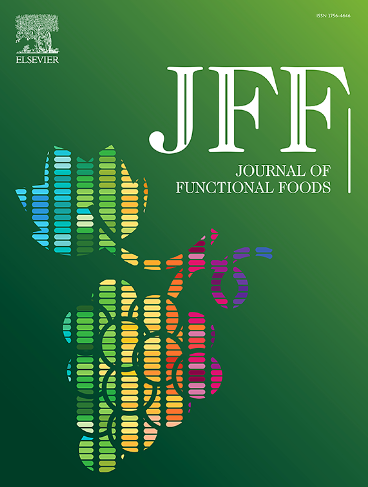一种新型酪氨酸酶抑制肽通过下调TRP-1/TRP-2的表达来抑制B16F10细胞的黑色素生成
IF 4
2区 农林科学
Q2 FOOD SCIENCE & TECHNOLOGY
引用次数: 0
摘要
酪氨酸酶抑制肽(TIPs)天然存在于哺乳动物以及农业和水产品中,由于其特殊的生物安全性,已成为合成皮肤增白剂的有希望的替代品。本研究在前期通过生物信息学筛选和分子动力学模拟等方法从裸星虫中鉴定出新型TIP (IIAPPERKY)的基础上,利用B16F10细胞阐明其抗黑素生成的机制。生化实验表明,IIAPPERKY显著降低黑色素合成和酪氨酸酶活性,同时增强抗氧化能力。分子对接证实IIAPPERKY与酪氨酸酶直接结合(−7.80 kcal/mol),提示有变构干扰。基因和蛋白表达分析显示,在转录和翻译水平上,酪氨酸酶相关蛋白-1 (TRP-1)和酪氨酸酶相关蛋白-2 (TRP-2)显著下调。这些发现表明,IIAPPERKY通过双重机制抑制黑色素生成:抗氧化剂驱动的TRP-1/TRP-2抑制和与酪氨酸酶的结合。其生物安全性和有效性突出了其在功能性化妆品和食品行业的潜在应用,扩大了农业资源的利用。本文章由计算机程序翻译,如有差异,请以英文原文为准。

A novel tyrosinase inhibitory peptide derived from Sipunculus nudus suppresses melanogenesis in B16F10 cells by down-regulating TRP-1/TRP-2 expression
Tyrosinase inhibitory peptides (TIPs), naturally abundant in mammals as well as agricultural and aquatic products, have emerged as promising alternatives to synthetic skin whitening agents due to their exceptional biosafety. Building upon our previous identification of the novel TIP (IIAPPERKY) from Sipunculus nudus through integrated bioinformatics screening and molecular dynamics simulations, this study aim to elucidate its anti-melanogenic mechanism using B16F10 cells. Biochemical assays revealed that IIAPPERKY significantly reduced melanin synthesis and tyrosinase activity while enhancing antioxidant capacity. Molecular docking confirmed direct binding between IIAPPERKY and tyrosinase (−7.80 kcal/mol), suggesting allosteric interference. Gene and protein expression analyses demonstrated marked downregulation of tyrosinase-related protein-1 (TRP-1) and tyrosinase-related protein-2 (TRP-2) at transcriptional and translational levels. These findings indicated that IIAPPERKY suppresses melanogenesis through dual mechanisms: antioxidant-driven inhibition of TRP-1/TRP-2 and binding to tyrosinase. Its biosafety and efficacy highlight potential applications in functional cosmetics and food industries, expanding the utilization of agricultural resources.
求助全文
通过发布文献求助,成功后即可免费获取论文全文。
去求助
来源期刊

Journal of Functional Foods
FOOD SCIENCE & TECHNOLOGY-
CiteScore
9.60
自引率
1.80%
发文量
428
审稿时长
76 days
期刊介绍:
Journal of Functional Foods continues with the same aims and scope, editorial team, submission system and rigorous peer review. We give authors the possibility to publish their top-quality papers in a well-established leading journal in the food and nutrition fields. The Journal will keep its rigorous criteria to screen high impact research addressing relevant scientific topics and performed by sound methodologies.
The Journal of Functional Foods aims to bring together the results of fundamental and applied research into healthy foods and biologically active food ingredients.
The Journal is centered in the specific area at the boundaries among food technology, nutrition and health welcoming papers having a good interdisciplinary approach. The Journal will cover the fields of plant bioactives; dietary fibre, probiotics; functional lipids; bioactive peptides; vitamins, minerals and botanicals and other dietary supplements. Nutritional and technological aspects related to the development of functional foods and beverages are of core interest to the journal. Experimental works dealing with food digestion, bioavailability of food bioactives and on the mechanisms by which foods and their components are able to modulate physiological parameters connected with disease prevention are of particular interest as well as those dealing with personalized nutrition and nutritional needs in pathological subjects.
 求助内容:
求助内容: 应助结果提醒方式:
应助结果提醒方式:


